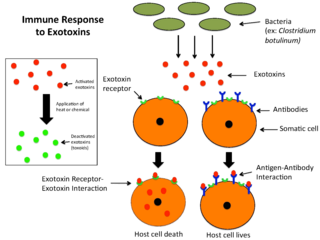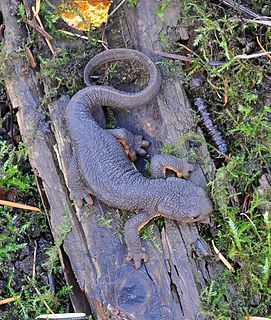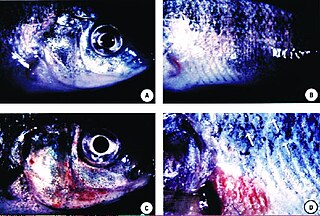
Tetraodontidae is a family of primarily marine and estuarine fish of the order Tetraodontiformes. The family includes many familiar species variously called pufferfish, puffers, balloonfish, blowfish, blowies, bubblefish, globefish, swellfish, toadfish, toadies, honey toads, sugar toads, and sea squab. They are morphologically similar to the closely related porcupinefish, which have large external spines. The scientific name refers to the four large teeth, fused into an upper and lower plate, which are used for crushing the hard shells of crustaceans and mollusks, their natural prey.

Skin is the layer of usually soft, flexible outer tissue covering the body of a vertebrate animal, with three main functions: protection, regulation, and sensation.

An exotoxin is a toxin secreted by bacteria. An exotoxin can cause damage to the host by destroying cells or disrupting normal cellular metabolism. They are highly potent and can cause major damage to the host. Exotoxins may be secreted, or, similar to endotoxins, may be released during lysis of the cell. Gram negative pathogens may secrete outer membrane vesicles containing lipopolysaccharide endotoxin and some virulence proteins in the bounding membrane along with some other toxins as intra-vesicular contents, thus adding a previously unforeseen dimension to the well-known eukaryote process of membrane vesicle trafficking, which is quite active at the host-pathogen interface.

Batrachotoxin (BTX) is an extremely potent cardio- and neurotoxic steroidal alkaloid found in certain species of beetles, birds, and frogs. The name is from the Greek word βάτραχος, bátrachos, 'frog'. Structurally-related chemical compounds are often referred to collectively as batrachotoxins. It is an extremely poisonous alkaloid. In certain frogs this alkaloid is present mostly on the skin. Such frogs are among those used for poisoning darts. Batrachotoxin binds to and irreversibly opens the sodium channels of nerve cells and prevents them from closing, resulting in paralysis. No antidote is known.

The Colorado River toad, also known as the Sonoran Desert toad, is found in northern Mexico and the southwestern United States. Its toxin, as an exudate of glands within the skin, contains 5-MeO-DMT and bufotenin.

Ostraciidae is a family of squared, bony fish belonging to the order Tetraodontiformes, closely related to the pufferfishes and filefishes. Fish in the family are known variously as boxfishes, cofferfishes, cowfishes and trunkfishes. It contains about 23 extant species in 6 extant genera.
Detoxification is a type of alternative-medicine treatment which aims to rid the body of unspecified "toxins" – substances that proponents claim have accumulated in the body and have undesirable short-term or long-term effects on individual health. Activities commonly associated with detoxification include dieting, fasting, consuming exclusively or avoiding specific foods, colon cleansing, chelation therapy, and the removal of dental fillings containing amalgam.

The rough-skinned newt or roughskin newt is a North American newt known for the strong toxin exuded from its skin.
Prymnesium parvum is a species of haptophytes (=Prymnesiophyta). The species is of concern because of its ability to produce a toxin, prymnesin. It is a flagellated alga that is normally found suspended in the water column. It was first identified in North America in 1985 and it is not known if it was introduced artificially. Toxin production mainly kills fish and appears to have little effect on cattle or humans. This distinguishes it from red tide, which are algal bloom whose toxins lead to harmful effects in people. Although no harmful effects are known, it is recommended not to consume dead or dying fish exposed to a P. parvum bloom. Prymnesium parvum of Haptophyta is sometimes termed a golden alga or a golden brown algae as is Chrysophyceae of Heterokontophyta but the taxonomy of algae is under complex revision leading to contradictions in terms especially in non scholarly texts such as those from state wildlife departments.

The longhorn cowfish, also called the horned boxfish, is a species of boxfish from the family Ostraciidae, recognizable by its long horns that protrude from the front of its head, rather like those of a cow or bull. They are a resident of the Indo-Pacific region and can grow up to 50 cm (20 in) long.

The yellow boxfish is a species of boxfish. It can be found in reefs throughout the Pacific Ocean and Indian Ocean as well as the southeastern Atlantic Ocean.

Pardachirus marmoratus, also known as the finless sole, the speckled sole or the Red Sea Moses sole, is a small fish from the Red Sea that secretes an ichthyotoxic milky substance from the base of its dorsal and cloacal fins. This secretion contains pardaxin, a lipophillic peptide that causes severe plasma membrane disruption resulting in cell leakage. The pardaxin containing secretion is used as a defensive mechanism against predators including sharks. Pardaxin is irritating to predator fish, particularly affecting the sensitive gills. Dr. Eugenie Clark conducted much of the early work on Pardachirus marmoratus.

Pumiliotoxin 251D is a toxic organic compound. It is found in the skin of poison frogs from the genera Dendrobates, Epipedobates, Minyobates, and Phyllobates and toads from the genus Melanophryniscus. Its name comes from the pumiliotoxin family (PTXs) and its molecular mass of 251 Daltons. When the toxin enters the bloodstream through cuts in the skin or by ingestion, it can cause hyperactivity, convulsions, cardiac arrest and ultimately death. It is especially toxic to arthropods, even at low concentrations.

Predatory dinoflagellates are predatory heterotrophic or mixotrophic alveolates that derive some or most of their nutrients from digesting other organisms. About one half of dinoflagellates lack photosynthetic pigments and specialize in consuming other eukaryotic cells, and even photosynthetic forms are often predatory.

Lactophrys triqueter also known as the smooth trunkfish, is a species of boxfish found on and near reefs in the Caribbean Sea, Gulf of Mexico and subtropical parts of the western Atlantic Ocean.
Ichthyotoxins are compounds which are either toxic to fish or are toxins produced by fish. The toxins can be found in gar eggs and the eggs of several other species' roe. It can also be found in some species of algae such as prymnesium parvum. They include euglenophycin and prymnesins, made by algae and can cause large-scale fish deaths, and ostracitoxin made by boxfish. Many toxin producing algal species can be found both in marine and fresh water environments when the algae is in bloom. The toxin is protein based and is poisonous to humans, small mammals, and some fish. An ichthyotoxic poisoning can cause symptoms ranging in severity dependent on how much toxin was consumed. The symptoms of an ichthyotoxin poisoning can include headache, vomiting, diarrhea, dizziness, drop in blood pressure, and many others.
Polymorphic toxins (PTs) are multi-domain proteins primarily involved in competition between bacteria but also involved in pathogenesis when injected in eukaryotic cells. They are found in all major bacterial clades.
Prymnesin-2 is an organic compound that is secreted by the haptophyte Prymnesium parvum. It belongs to the prymnesin family and has potent hemolytic and ichthyotoxic properties. In a purified form it appears as a pale yellow solid. P. parvum is responsible for red harmful algal blooms worldwide, causing massive fish killings. When these algal blooms occur, this compound poses a threat to the local fishing industry. This is especially true for brackish water, as the compound can reach critical concentrations more easily.

A Kambo cleansing, also known as a Kambo circle or Kambo ceremony, Kambo, vacina-do-sapo, or sapo, is a purge using skin secretions of the kambô, a species of frog. The effects on humans usually include nausea, vomiting, and diarrhea; Kambo's usage produced several deaths. Kambo, which originated as a folk medicine practice among the Amazon indigenous peoples, is also administered as an alternative medicine treatment in the West, often as a pseudoscientific cleanse or detox. The ceremony involves burning an arm or leg and applying the Kambo secretion directly to the burn. Promoters claim that Kambo helps with several illnesses or injuries. There are ethnographic studies on the use of Kambo in traditional Noke Kuin medicine in the region of the state of Acre, in the Brazilian Amazon. Still, there is no scientific evidence that it is an effective treatment.
Grammistins are peptide toxins synthesised by glands in the skin of soapfishes of the tribes Grammistini and Diploprionini which are both classified within the grouper subfamily Epinephelinae, a part of the family Serranidae. Grammistin has a hemolytic and ichthyotoxic action. The grammistins have secondary structures and biological effects comparable to other classes of peptide toxins, melittin from the bee stings and pardaxins which are secreted in the skin of two sole species. A similar toxin has been found to be secreted in the skin of some clingfishes.














